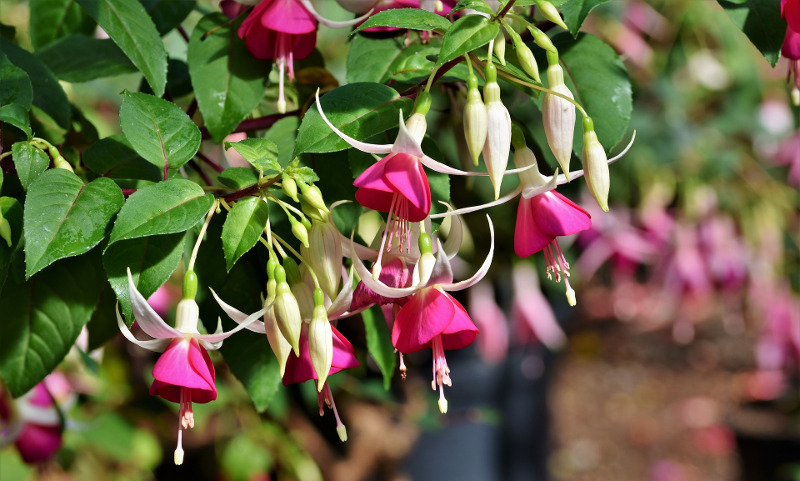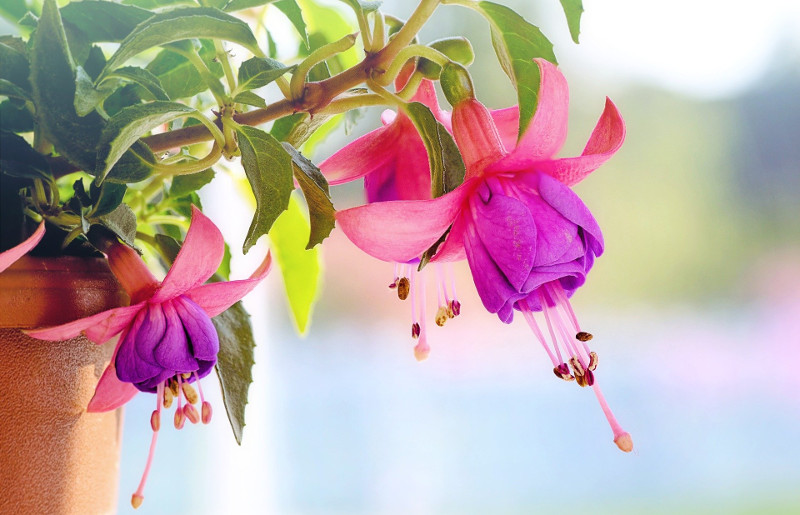Fuchsia is a genus of flowering plants that consists mostly of shrubs or small trees. The first to be scientifically described, Fuchsia triphylla, was discovered on the Caribbean island of Hispaniola. Almost 110 species of Fuchsia are recognized; the vast majority are native to South America and the Caribbean.
Growing zones 8 to 11 as perennials, and as an annual in all colder zones, Fuchsias like part shade to full shade. Flower clusters dangling like teardrops from the tips of the branch come in shades of red, magenta, pink, purple and white.
Usually 1 to 2 feet tall with a similar spread, gardeners love this plant in hanging baskets and containers. Fussy about moisture and temperature, as long as the soil stays moist, this plant will thrive.

Planting Fuchsia
Usually grown in a container or a hanging basket, Fuchsia plants are not difficult to maintain. This plant does not like to be too hot or too dry, so position the container in an area that has part to full shade. Plant in rich, well-drained soil, after the temperatures are above 50 degrees at night.
Be sure that the container has drainage holes, as this plant does not like wet feet. On the contrary, this plant hates dry heat and drought conditions. Daily watering is a must for this flowering plant.
Growing 1 to 2 feet in a year, and producing bountiful blooms, Fuchsias will benefit from regular feedings.
Watering Fuchsia
Fuchsia plants like consistently moist soil and moist roots. Well-draining soil and a pot with drainage holes is a must as roots sitting in soggy conditions can cause root rot. It is best to keep this plant well hydrated.
A Fuchsia in full bloom may need watering twice a day. Remember that container plants will dry out a lot faster than in ground plants. If you live in a dry area, it may be a challenge to keep this plant well hydrated. When watering, slowly add water until it drains out of the bottom of the container.

Fertilizing Fuchsia
Fuchsias burst with teardrop flowers throughout the blooming season. As a result of this, they have a big appetite and will need regular feeding. Use a balanced fertilizer, one that contains equal amounts of nitrogen, phosphorus and potassium. For container grown Fuchsias, adding 1/2 teaspoon of water-soluble balanced fertilizer to a gallon of water every two weeks is good. This will help to promote flowering throughout the season.
Hardy Fuchsias can also be fertilized with well-composted material, spread around the base of the plant in the spring and in the fall.
Pruning Fuchsia
Typically, pruning of a Fuchsia plant is not necessary for the plant to grow. With that said, all types of Fuchsia plants can benefit from removal of spent blooms. Pinching the tips of growing plants can encourage full and bushy growth.
Flowers appear on the new growth, so it is a good idea to pick off the spent blooms. Cutting back a hanging Fuchsia plant to bare branches can get rid of a straggly look to the plant. You can even put those cuttings into water to start new plants.
Caring For Fuchsia in Pots
Container grown Fuchsias require a fast draining potting soil and good drainage. Choose a container with drainage holes that is one size larger than the store bought pot. Choose a location that gets partial to full shade each day. Plant your Fuchsia in regular peat-based potting soil.
This plant likes it’s roots moist but not sitting in soggy soil. Water when the surface of the soil is dry to the touch. A Fuchsia in full bloom will require watering once or twice a day depending during warm and dry conditions.

Winter Care for Fuchsia
Often planted as an annual, most gardeners discard the plant when the weather turns colder. It is possible to try and continue to grow these plants indoors over the winter. Place the container in an area with bright light and humid conditions. Keep the soil moist throughout the winter. You can also cut the plant back to a few inches and place it in a dark dry area for the winter. Water just enough so the soil is not bone dry.
In the spring, bring the plant outdoors and hope it blooms again.
Fuchsia Plants For Sale
Common Fuchsia Care Questions
Do Fuchsias Grow Back Every Year?
In warmer climates, fuchsia can come back year after year, if the temperatures stay warm (these are called tender perennials) however in most climates, they are grown as annuals.
How Do You Keep A Fuchsia Blooming?
Fuchsia bloom on new growth, so keeping your fuchsia pinched back, after blooms are spent, will help them to continue to bloom. Pinching back each stem by 1/4 to 1/2 as the flowers fade will encourage new growth and new blooms. Usually, the reblooms will appear in around 6 weeks. Continue the pinch throughout the summer.
Why Does Fuchsia Leave Turning Yellow And Brown?
Most often, yellowing leaves on fuchsia plants are caused by watering habits, either too much or too little. Yellowed leaves may also be caused by soil that is nutritionally deficient in magnesium. Browned leaves may be caused by a variety of fungal diseases and all affected parts of the plant should be removed and disposed of.
The base of the plant should be kept free from any debris, trim and thin the plant out to allow for better air circulation, and water the plant only from the base, taking care not to get the leaves wet.
Do Fuchsias Spread?
Fuchsia does spread, producing new plants from spreading roots, but can easily be divided and transplanted as long as plenty of roots is dug up and moved with them.
Do Fuchsias Like Sun Or Shade?
Fuchsias prefer lots of filtered sunlight and dappled shade. The do not like, or tolerate temperatures above the low 80's so be sure they're protected from the heat in the afternoon hours.
How To Revive A Fuchsia Plant?
A fuchsia plant can be revived by a serious cutting back. In the fall, remove existing flowers, leaves, and branches. Fuchsias bloom on new wood, and this is the way to encourage new growth. In warmer climates, this may happen right away, pinch that new growth off, too! This will help promote new, bushier growth when spring rolls around.
What Is The Growth Rate Of Fuchsia?
Fuchsia are moderately fast growers and can grow up to 2 feet a year, in optimal conditions.
Have a question about Fuchsia? Fill out the form below and we will try and get back to your question as soon as possible. We may even feature your question on this article to help other gardeners!
 |
Author Chris Link - Published 07-23-2021 |
